The Paper Recycling Market is estimated to be valued at USD 7.9 billion in 2025 and is projected to reach USD 13.8 billion by 2035, registering a compound annual growth rate (CAGR) of 5.6% over the forecast period.
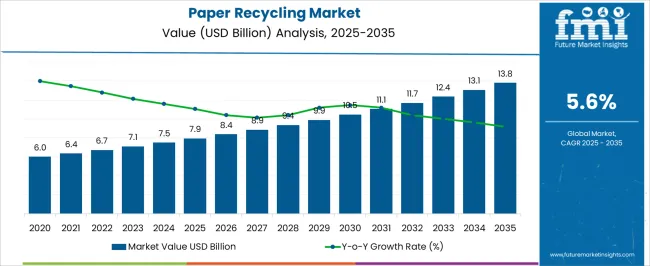
| Metric | Value |
|---|---|
| Paper Recycling Market Estimated Value in (2025 E) | USD 7.9 billion |
| Paper Recycling Market Forecast Value in (2035 F) | USD 13.8 billion |
| Forecast CAGR (2025 to 2035) | 5.6% |
The paper recycling market is growing consistently, driven by increasing regulatory emphasis on circular economy models, rising awareness of sustainable resource utilization, and expanding demand for cost-effective raw material alternatives. The market is supported by widespread collection networks, advanced recycling processes, and industrial adoption of recycled paper in packaging, printing, and specialty applications.
Growth is particularly reinforced by demand from packaging manufacturers, who rely on recycled inputs to meet corporate sustainability commitments and consumer preferences for eco-friendly solutions. The current landscape reflects strong participation from both developed and developing regions, with infrastructure investments supporting efficiency in collection and processing.
Future market prospects are shaped by technological improvements in fiber recovery, increasing open-loop recycling rates, and broader application of recycled paper in high-volume industries. With waste reduction targets tightening globally, the paper recycling market is expected to remain on a stable upward trajectory.
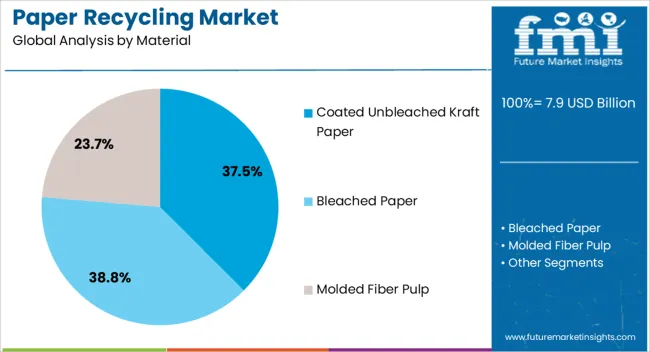
The coated unbleached kraft paper segment accounts for approximately 37.5% share of the material category in the paper recycling market. This segment’s strength lies in its extensive use across industrial packaging and its recyclability compared to other coated formats.
Its durability and printability enhance its utility in consumer-facing applications while still allowing effective fiber recovery. The segment has benefited from high collection rates and established recycling processes, ensuring a consistent feedstock supply.
The growing emphasis on sustainable packaging solutions in food, beverages, and retail industries has further reinforced demand for recycled kraft paper. With regulatory and corporate commitments toward reducing virgin material dependency, the coated unbleached kraft paper segment is expected to maintain strong growth momentum.
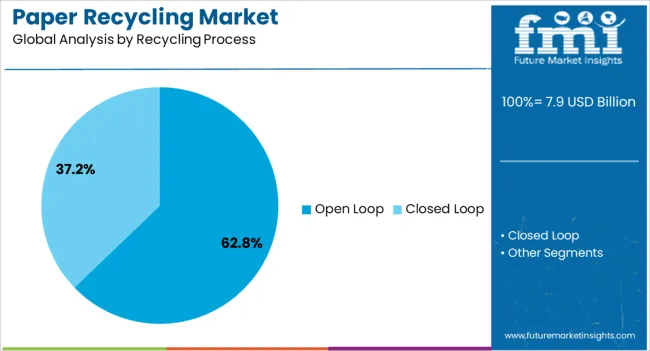
The open loop segment dominates the recycling process category, holding approximately 62.8% share. Its leadership reflects the ability of open loop systems to reintroduce recycled paper into new product categories beyond their original applications.
This flexibility maximizes resource utilization and extends the lifecycle of fibers, making it a preferred recycling approach. The segment benefits from widespread industrial adoption, particularly in packaging, where recycled fibers are used extensively.
Cost efficiency and environmental alignment have further strengthened its dominance, particularly as industries seek scalable and practical recycling solutions. With ongoing policy initiatives supporting circular economy frameworks, open loop recycling is anticipated to remain the most prominent process in the market.
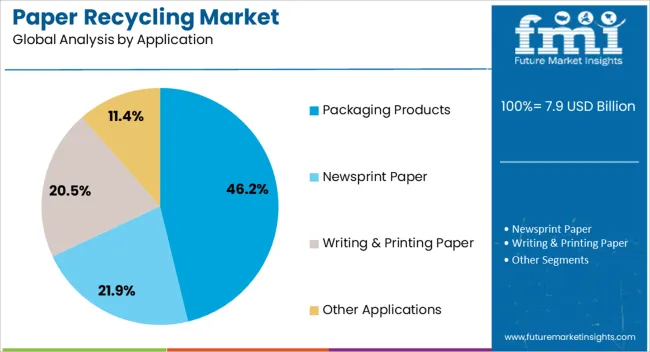
The packaging products segment leads the application category, accounting for approximately 46.2% share of the paper recycling market. This dominance is reinforced by the packaging industry’s growing dependence on recycled paper to meet sustainability and cost-efficiency goals.
Packaging manufacturers are integrating recycled fibers into corrugated boxes, cartons, and flexible packaging solutions, benefiting from consumer demand for eco-friendly alternatives. The segment’s growth is also supported by the rapid expansion of e-commerce, which has driven higher consumption of recycled paper-based packaging.
As sustainability commitments become central to global supply chains, packaging products derived from recycled paper are expected to retain a leading role in market growth.
The paper recycling market was tipped to be USD 6 billion in value in 2020. The market likely progressed at a consistent CAGR of 3.1% over the historical period from 2020 to 2025.
Significant industrial shutdowns in various industries that use recycled paper packaging limited the market's growth. As the pandemic resulted in restrictions, the packaging industry was negatively impacted, which, in turn, slowed down the growth of the paper recycling market. However, as the effects of the pandemic receded, the market experienced a recovery in growth. By the end of the historical period, the value of the paper recycling market had grown to USD 7.1 billion.
| Market Value (2020) | USD 6 billion |
|---|---|
| Historical CAGR (2020 to 2025) | 3.1% |
| Historical Market Valuation (2025) | USD 7.1 billion |
Long-term Analysis of the Paper Recycling Market
The paper recycling market is estimated to have a size of USD 7.9 billion in 2025. The progress of the market is pegged to be normal over the period from 2025 to 2035, with a CAGR of 5.7%.
Sustainability measures, both implemented by the government and self-imposed, are leading industrialists to embrace materials like recycled paper. As a result, the application of recycled paper in a variety of industries, including cosmetics and chemicals, is increasing. With the effects of the pandemic subsiding, the market is expected to progress faster in the forecast period than in the historical period.
The use of recycled paper in packaging is bolstered by the material's flexibility to manufacturers. Recycled paper in the form of molded pulp fiber provides toughness to manufacturers while still being easy to handle. By 2035, it is anticipated that the value of the market is likely to have jumped to USD 13.1 billion.
An analysis of the paper recycling market is attempted with respect to two categories: material and recycling process. Manufacturers are closely screening the material used in packaging, and high-quality paper is being pursued. There are two major types of recycling processes, but one is preferred over the other.
Molded fiber pulp is the predominant material used in paper recycling. For 2025, molded fiber pulp is expected to account for 53.1% of the market share by material.
Molded fiber pulp is winning over end-users due to the flexibility it provides. The material is easy to handle but still provides safety to the content inside the packaging, notably limiting the damage caused by food when it hits the inside of the packaging. Thus, molded fiber pulp is the material preferred by end users.
| Attributes | Details |
|---|---|
| Top Material | Molded Fiber Pulp |
| CAGR (2025 to 2035) | 53.1% |
Open loop recycling triumphs closed loop recycling. For 2025, open loop recycling process is expected to account for 72.4% of the market share.
Open loop recycling allows multiple further uses of the paper being recycled. Thus, manufacturers are able to diversify the use of recycled paper, especially with the increase in the application of the product in industries and commercial spaces.
| Attributes | Details |
|---|---|
| Top Recycling Process | Open Loop |
| CAGR (2025 to 2035) | 72.4% |
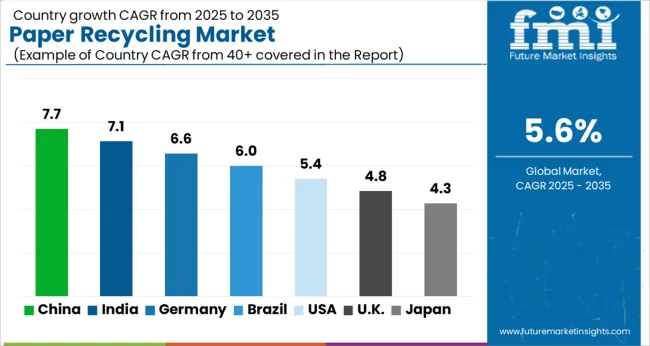
The Asia Pacific is expected to be a lucrative region for the market. The region's increased packaging needs are being supported by recycled paper. In addition, countries like China and India in the Asia Pacific are also importing paper for recycling purposes.
Europe is another significant region for the market. Stringent regulations for industries are seeing manufacturers turn to non-traditional packaging solutions, and recycled paper is one of them.
China is set to be one of the promising countries in the market. For the 2025 to 2035 period, the CAGR for China is estimated to be an encouraging 7.2%.
China has imposed strict restrictions on the import of waste material, including paper. However, the pulp and paper industry in the country, reputed to be the biggest in the world, ensures that recycled paper continues to grow strong. Thus, there is an emphasis on domestic supply in China.
India is home to several paper mills that import significant amounts of waste paper. The United States and Canada are two prominent countries that supply waste paper to India. The domestic supply of paper, augmented by imports, is leading to more production of recycled paper in the country. For the forecast period, the CAGR for India is pegged to a healthy 6.7%.
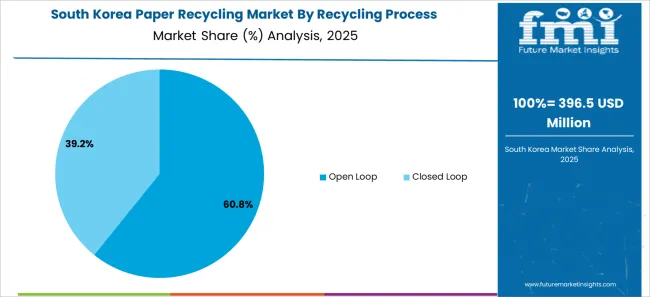
The recycling paper market is being bolstered by the inclination toward the technology of Koreans. For example, EAPS is a Korean company that has come up with an AI-based robot. It is a recyclable robot that helps sort waste material, making the recycling process more efficient. For the forecast period, the CAGR for South Korea is estimated to be a promising 6.1%.
The government in Thailand has taken positive steps to expand the scope of paper recycling in the country. For example, in February 2025, the Thai government's industry ministry, in collaboration with SCG Packaging, launched an initiative to take in a significant amount of paper and turn it into beds, desks, tables, and more. Thus, government programs are keeping the demand for paper recycling flowing in Thailand. For the forecast period, the CAGR for Thailand is estimated to be a normal 5.8%.
In the United Kingdom, people have ease of access when it comes to disposing of paper for recycling. Recycling bins are common in the streets of the country, adding ease to the paper recycling process. Thus, despite the fall in the rate of recycling in the country, the market still has prospects in the United Kingdom. The market is expected to register a modest CAGR of 5.1% in the United Kingdom over the forecast period.
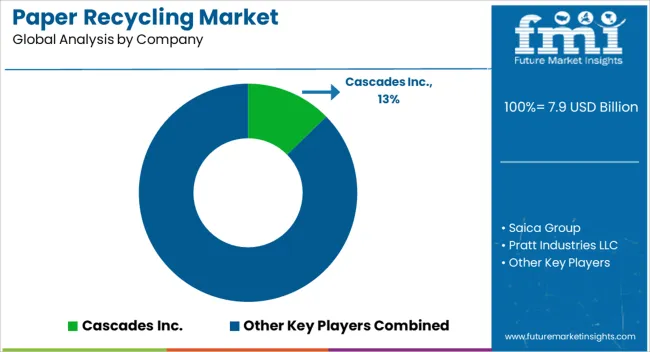
Leveraging technology and government aid to refine the recycling process is a common objective among market players. Market players are also eager to discover new avenues of paper procurement to boost production.
Paper recycling is a process that can be easily achieved at home. Thus, the market is highly fragmented, with start-ups and small-scale players abundant.
Recent Developments in the Paper Recycling Market
The global paper recycling market is estimated to be valued at USD 7.9 billion in 2025.
The market size for the paper recycling market is projected to reach USD 13.8 billion by 2035.
The paper recycling market is expected to grow at a 5.6% CAGR between 2025 and 2035.
The key product types in paper recycling market are coated unbleached kraft paper, bleached paper and molded fiber pulp.
In terms of recycling process, open loop segment to command 62.8% share in the paper recycling market in 2025.






Full Research Suite comprises of:
Market outlook & trends analysis
Interviews & case studies
Strategic recommendations
Vendor profiles & capabilities analysis
5-year forecasts
8 regions and 60+ country-level data splits
Market segment data splits
12 months of continuous data updates
DELIVERED AS:
PDF EXCEL ONLINE
Paper Paperboard Wood Recycling Market Size and Share Forecast Outlook 2025 to 2035
Paper Edge Protector Market Size and Share Forecast Outlook 2025 to 2035
Paper Cup Lids Market Size and Share Forecast Outlook 2025 to 2035
Paper Pallet Market Size and Share Forecast Outlook 2025 to 2035
Paper and Paperboard Packaging Market Forecast and Outlook 2025 to 2035
Paper Wrap Market Size and Share Forecast Outlook 2025 to 2035
Paper Cups Market Size and Share Forecast Outlook 2025 to 2035
Paper Core Market Size and Share Forecast Outlook 2025 to 2035
Paper Bags Market Size and Share Forecast Outlook 2025 to 2035
Paper Processing Resins Market Size and Share Forecast Outlook 2025 to 2035
Paper Tester Market Size and Share Forecast Outlook 2025 to 2035
Paper Napkin Converting Lines Market Size and Share Forecast Outlook 2025 to 2035
Paper Packaging Tapes Market Size and Share Forecast Outlook 2025 to 2035
Paper Napkins Converting Machines Market Size and Share Forecast Outlook 2025 to 2035
Paper Coating Binders Market Size and Share Forecast Outlook 2025 to 2035
Paper Core Cutting Machine Market Size and Share Forecast Outlook 2025 to 2035
Paper Release Liners Market Size and Share Forecast Outlook 2025 to 2035
Paper Coating Materials Market Size and Share Forecast Outlook 2025 to 2035
Paper Pigments Market Size and Share Forecast Outlook 2025 to 2035
Paper Honeycomb Market Size and Share Forecast Outlook 2025 to 2035

Thank you!
You will receive an email from our Business Development Manager. Please be sure to check your SPAM/JUNK folder too.
Chat With
MaRIA